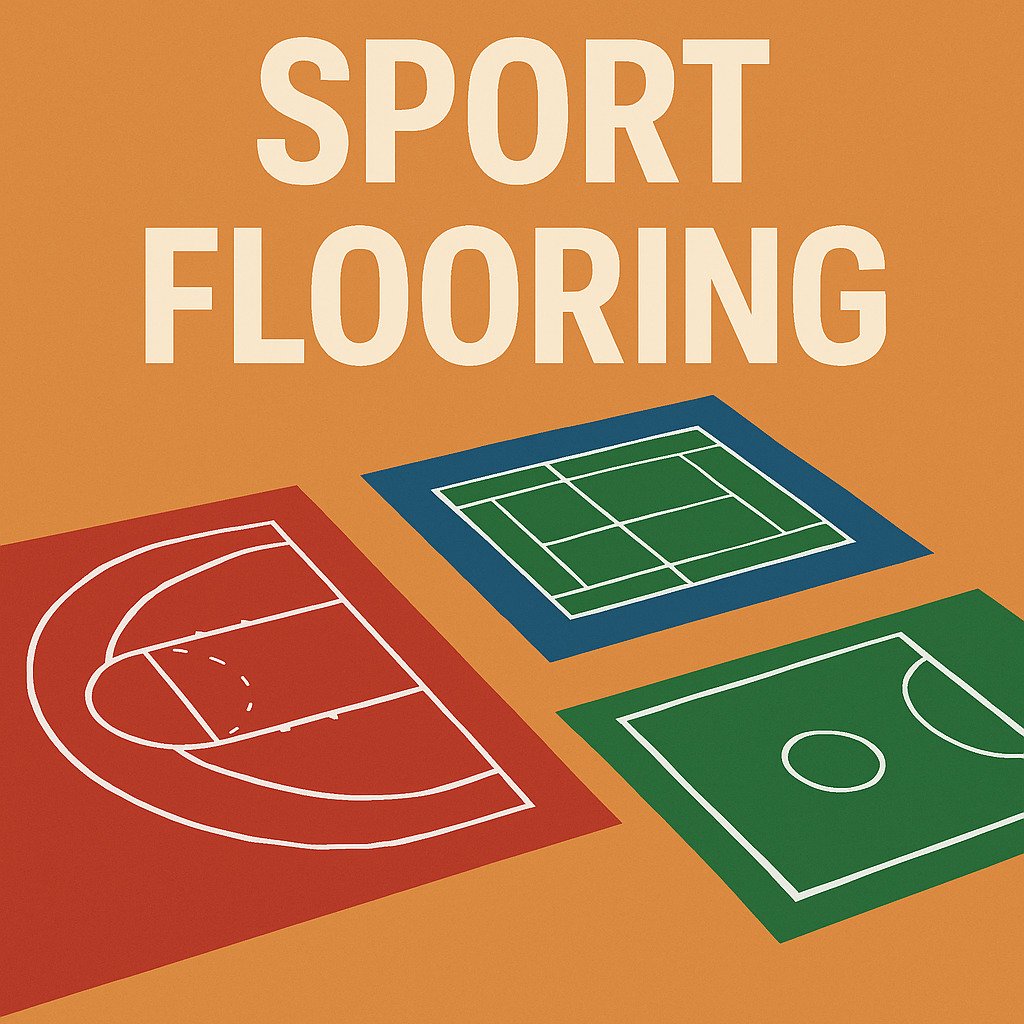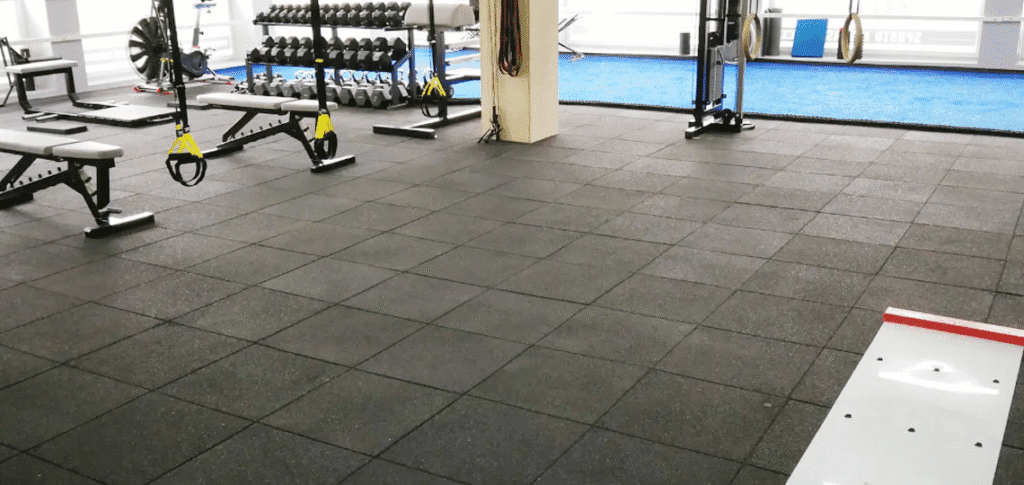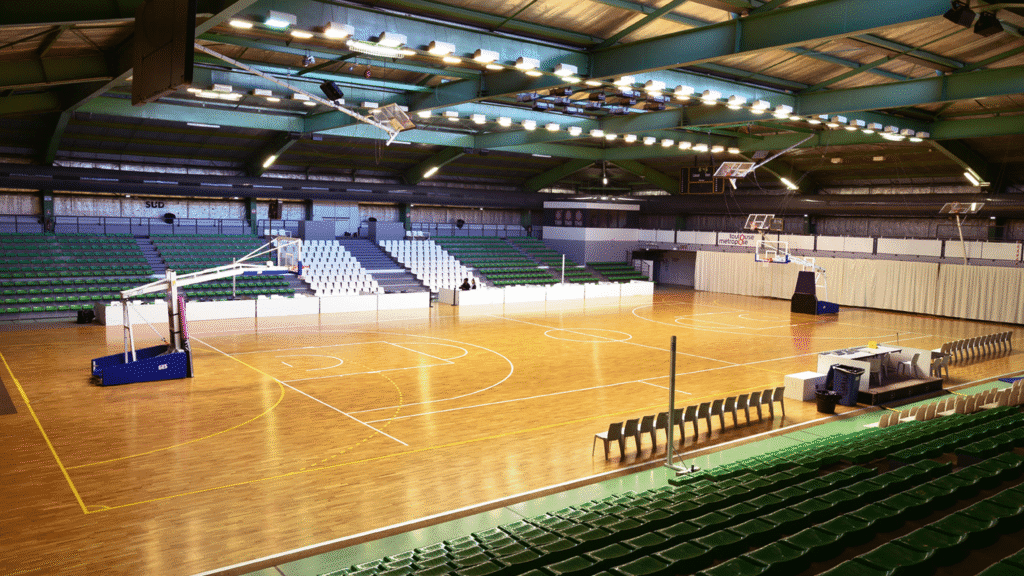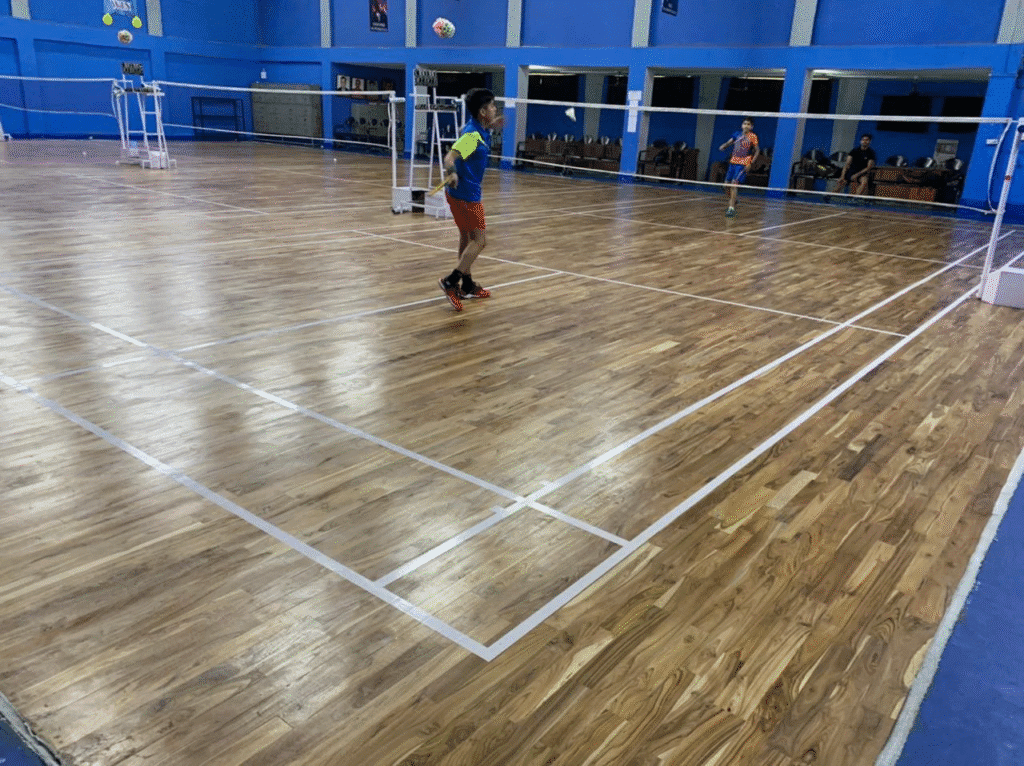
Did you know that the right sports flooring can reduce injury risks by up to 40% while enhancing athletic performance? Whether you’re managing a professional arena, a community gym, or an outdoor court, the surface beneath your feet plays a crucial role in safety, mobility, and overall user satisfaction. Overlooking this essential component can result in more accidents, decreased performance, and even damage to your facility’s reputation.
This blog will guide you through everything you need to know about sport flooring, from selecting the right material for specific activities to understanding the benefits of investing in high-quality surfaces. We’ll explore how sport flooring directly impacts athlete safety, enhances performance, and helps facilities maintain their prestige. By the end, you’ll have the insight needed to make informed decisions that benefit your athletes and your bottom line.
Up next, we’ll break down the different types of sport flooring and how to choose the perfect match for your specific needs. Let’s get started!
Types of Sport Flooring

Choosing the right sport flooring is crucial for athletic performance, safety, and long-term facility success. Here, we’ll take an in-depth look at the most common types of sport flooring, their features, and where they’re best suited.
Hardwood Flooring
Known for its elegance and resilience, hardwood flooring is a classic choice for indoor sports like basketball, volleyball, and aerobics. Facilities favor this surface due to its smooth, polished look and unmatched durability.
Benefits of Hardwood Flooring:
- Excellent Performance: Offers consistent ball bounce and excellent traction.
- Durability: With proper maintenance, hardwood floors can last decades.
- Aesthetic Appeal: Provides a professional, high-end appearance for sports venues.
Ideal Applications:
- Basketball courts
- Volleyball courts
- Multi-sport gyms
Regular maintenance, such as sanding and refinishing, is required but well worth the investment for its longevity.
Rubber Flooring
Rubber flooring is a popular choice for weightlifting areas, fitness centers, and multipurpose gyms. Its shock-absorbing properties reduce stress on joints and equipment.
Benefits of Rubber Flooring:
- Impact Absorption: Protects athletes and gym equipment from jarring impacts.
- Noise Reduction: Dampens sound in active environments.
- Easy Maintenance: Simple to clean and resistant to sweat and high foot traffic.
Ideal Applications:
- Weight rooms
- Functional training areas
- Schools and community gyms
Rubber flooring comes in various thicknesses and styles, including tiles and rolls, to suit specific facility needs.
Artificial Turf
Indoor and outdoor sports like soccer, football, and field hockey often rely on artificial turf to replicate the feel of natural grass while remaining low-maintenance.
Benefits of Artificial Turf:
- Weather Resistance: Offers a consistent playing surface in various conditions.
- Low Upkeep: No need for mowing, watering, or re-seeding.
- Year-Round Use: Stays functional regardless of season.
Ideal Applications:
- Indoor soccer fields
- Football training areas
- Multi-use outdoor fields
Modern artificial turf options also incorporate padding layers to improve shock absorption and reduce injury risks.
Vinyl Flooring
Vinyl flooring is versatile, affordable, and ideal for multi-purpose sports facilities. Its wide range of colors and patterns allows for customization to match a team or facility’s branding.
Benefits of Vinyl Flooring:
- Versatility: Suitable for various low-impact sports and activities.
- Easy Installation: Comes in sheets or tiles for quick setup.
- Cost Efficiency: Often more budget-friendly than other options.
Ideal Applications:
- Dance studios
- Multi-purpose recreation centers
- Low-impact exercise areas
Vinyl flooring is slip-resistant and easy to clean, making it a practical option for many sports environments.
Outdoor Sport Surfaces
For outdoor facilities like tennis courts, basketball courts, and running tracks, materials like acrylic, polyurethane, and asphalt are commonly used.
Benefits of Outdoor Sport Surfaces:
- Durability: Withstands harsh weather conditions and frequent use.
- Traction and Safety: Provides slip resistance and consistent grip for outdoor play.
- Design Options: Customizable with different colors and markings for specific sports.
Ideal Applications:
- Tennis courts
- Running tracks
- Outdoor basketball courts
These surfaces often feature UV-resistant coatings to maintain their look and performance over time.
Choosing the Right Sport Flooring
When selecting a flooring type for your facility, consider factors like the specific sports being played, the level of usage, and your budget. Each type of sport flooring offers unique benefits and is designed to excel in certain environments. By matching the right flooring to your facility’s needs, you create a safe, high-performance space that athletes and users will appreciate
Key Factors to Consider When Choosing Sport Flooring

Choosing the right sport flooring involves more than just selecting a surface—it’s about creating an environment where athletes can perform at their best while staying safe. Here are the key factors to consider to help ensure your decision meets the needs of both your facility and its users.
1. Sport-Specific Needs
The type of sport being played is the primary influence on your choice of flooring. Different activities demand different surface characteristics to optimize performance and safety.
- Example: Hardwood flooring is ideal for basketball and volleyball due to its capacity to deliver consistent ball bounce and smooth traction.
- Tip: List the primary sports hosted at your facility, then research the surfaces most commonly recommended for them.
2. Safety Features
Safety should be a top priority for any sports facility. Flooring that minimizes the risk of slips, falls, and injuries not only protects athletes but also safeguards facility operators from liability issues.
- Look for features like shock absorption, which lowers stress on joints.
- Choose materials with slip resistance to reduce the likelihood of falls.
- Example: Rubber flooring in weight rooms offers excellent traction and cushioning for activities with heavy impacts.
3. Durability
Investing in durable sport flooring pays off in the long term. A high-quality surface can withstand heavy foot traffic, frequent activities, and even rough usage while maintaining its performance.
- Key consideration: Flooring in multi-purpose gyms or arenas must endure diverse activities, from intense workouts to casual sports.
- Tip: Opt for materials with proven lifespan, such as rubber or hardwood, for high-demand areas to avoid frequent replacement costs.
4. Maintenance Requirements
Ease of maintenance is critical to preserving the life of your flooring and ensuring it remains safe for use.
- Low-maintenance options: Vinyl and rubber flooring are known for being easy to clean, requiring only routine sweeping and occasional mopping.
- Detailed requirements: High-end flooring like hardwood may involve regular sanding and refinishing to maintain its appearance and functionality.
- Pro tip: Choose a product with clear manufacturer instructions for care and cleaning to avoid costly mistakes.
5. Budget
While price is always a significant factor, it’s important to balance cost with quality. Opting for cheaper flooring can lead to higher replacement costs, frequent repairs, or increased maintenance efforts.
- Practical advice: Determine your budget beforehand and compare options that meet your requirements without compromising quality.
- Long-term savings: High-quality sport flooring often reduces expenses over time by avoiding frequent replacements.
6. Aesthetic Appeal
The look of your sport flooring can enhance the overall ambiance of your facility and contribute to its branding.
- Flooring is available in a range of colors, patterns, and design options, allowing you to customize the appearance to match your facility’s theme or team’s branding.
- Example: Vinyl flooring can be tailored with logos and custom lines to boost your facility’s aesthetic appeal while accommodating multi-purpose use.
Summing Up
Selecting the right sport flooring balances performance, safety, and aesthetics with practical considerations like maintenance and cost. Evaluate the specific needs of your facility and compare suitable materials to make an informed decision. Not only will the right flooring provide a safe and functional environment for athletes, but it will also reflect positively on your facility’s reputation.
Benefits of High-Quality Sport Flooring

Investing in high-quality sport flooring is more than an aesthetic or functional choice—it’s a strategic decision that impacts athletes, facilities, and long-term expenses. Here’s how premium sport flooring can deliver significant benefits.
1. Enhanced Athletic Performance
High-quality sport flooring is designed to optimize performance by providing consistent surface properties tailored to the sport being played.
- Improved Traction: Premium flooring materials enhance grip, allowing athletes to move confidently and execute precise maneuvers.
- Uniform Playing Surface: Consistent bounce and shock absorption ensure fairness and precision, especially in sports like basketball or volleyball.
- Example in Action: A basketball court with high-grade hardwood flooring facilitates better ball handling and reduces disruptions caused by uneven surfaces.
2. Reduced Risk of Injuries
Quality flooring is engineered with safety features that protect athletes from common sports-related injuries.
- Shock Absorption: Reduces impact on joints and minimizes overuse injuries.
- Slip Resistance: Prevents dangerous slips and falls, particularly in high-intensity sports.
- Specific Benefit Example: Rubber flooring in weight rooms absorbs the impact of dropped weights, preventing ankle and joint injuries for lifters.
3. Improved Facility Reputation
For sports facilities, high-quality flooring is often a hallmark of professionalism and attention to detail.
- Enhanced User Satisfaction: Athletes and visitors appreciate the comfort, safety, and aesthetics provided by premium surfaces.
- Competitive Edge: Facilities with top-tier flooring stand out, attracting more athletes, events, and memberships.
- Highlight: A soccer training facility with cutting-edge artificial turf tends to draw more teams due to the excellent playing experience it offers.
4. Long-Term Cost Savings
While high-quality flooring often requires a larger upfront investment, its durability and low maintenance translate to significant savings over time.
- Durability: Premium materials resist wear and tear from heavy use, reducing the need for frequent repairs or replacement.
- Low Maintenance Requirements: Advanced surfaces are easier to clean and less prone to damage, saving time and operational costs.
- Practical Example: A multi-sport facility using vinyl flooring sees fewer repair needs compared to lower-grade options, resulting in long-term financial efficiency.
Why Quality Matters
The flooring in your sports facility sets the foundation for success—literally. It enhances performance, protects athletes, and positions your facility as a top-tier destination. Whether you’re managing professional arenas or community centers, investing in high-quality sport flooring is an investment in safety, reputation, and long-term value.
Choose wisely, and your flooring will work as hard as your athletes do.
Common Mistakes to Avoid When Choosing Sport Flooring

Selecting the right sport flooring is a crucial decision, yet mistakes are common and can lead to costly repercussions. Avoid these pitfalls to ensure your facility is safe, functional, and aligned with its purpose.
1. Choosing the Wrong Type of Flooring for Specific Sports
One of the most frequent errors is selecting a flooring type that doesn’t match the intended activities. Different sports require specific surface qualities to ensure safety and performance.
- Example: Hardwood flooring is excellent for basketball but unsuitable for weight rooms due to its inability to handle heavy impacts.
- How to Avoid It: Identify the primary sports and activities your facility will host, and research the flooring options designed for those needs. For instance, rubber flooring is ideal for weightlifting areas, while artificial turf works best for indoor soccer fields.
2. Ignoring Maintenance Requirements
Not accounting for maintenance needs can lead to premature wear and an unintended increase in operational costs. Some flooring types require regular upkeep, such as refinishing or deep cleaning, to maintain their performance and longevity.
- Example: Hardwood floors need sanding and refinishing periodically, while rubber flooring requires consistent cleaning to remove grime.
- How to Avoid It: Understand the upkeep requirements for your chosen flooring and factor maintenance into your decision-making process. Ensure staff are trained on proper care techniques, and budget for routine maintenance.
3. Overlooking Safety Standards and Certifications
Ignoring safety features or failing to check certifications can put athletes at risk and expose your facility to liability. Essential safety elements like slip resistance and shock absorption are critical for any sports surface.
- Example: Installing flooring without adequate impact absorption can lead to joint injuries for players who frequently jump, such as basketball or volleyball athletes.
- How to Avoid It: Prioritize flooring options that meet recognized safety certifications, such as those from ASTM International or EN standards, to guarantee quality and safety compliance.
4. Focusing Solely on Cost
Choosing the cheapest option may seem like a good financial decision initially, but it often results in higher long-term costs due to frequent repairs, replacements, or poor performance.
- Example: Generic flooring might save money upfront, but its lack of durability could mean costly replacements within a few years.
- How to Avoid It: Consider the total cost of ownership, including durability, maintenance, and long-term performance. High-quality flooring may require a larger initial investment but offers better value over time.
5. Neglecting Aesthetic and Functional Needs
A common mistake is prioritizing functionality over aesthetics, or vice versa, without balancing the two. Flooring that doesn’t suit your facility’s design or branding can detract from user experience, while a purely aesthetic choice may lack the durability or performance required.
- How to Avoid It: Choose a flooring option that meets both technical needs and complements the overall look of the facility. For example, vinyl flooring offers versatility in both function and style, making it a great choice for multi-purpose spaces.
Making the Right Decision
Avoiding these mistakes requires a well-thought-out approach. Evaluate your facility’s specific needs, budget, and long-term goals to make an informed decision. By selecting the right sport flooring, you enhance athlete safety, improve performance, and protect your investment for years to come.
Maintenance Tips for Sport Flooring

Proper maintenance is the key to preserving the longevity, safety, and performance of sport flooring. With the right care routines, your flooring can stay in top condition and provide a safe, high-quality experience for athletes. Here are essential maintenance tips to help you protect your investment.
1. Establish a Daily Cleaning Routine
Regular cleaning keeps sport flooring free of dirt, dust, and debris that can degrade its surface over time.
- Sweeping and Mopping: Sweep the area daily to remove dust and grit. Use a soft-bristle broom or microfiber mop to avoid scratches.
- Wet Mop for Deeper Cleaning: Use a damp mop and neutral pH cleaner to tackle spills and scuff marks. Avoid over-wetting the surface, as excess water can damage certain materials like hardwood.
- Immediate Spill Cleanup: Wipe up spills as soon as possible to prevent stains or slippery spots.
2. Perform Periodic Inspections
Regular inspections ensure small issues are addressed before they escalate into costly repairs.
- Look for Wear and Tear: Check for signs of damage such as cracks, warping, or uneven surfaces. These can impact safety and performance if left unaddressed.
- Inspect Safety Features: Ensure slip-resistant surfaces and shock-absorbing layers are functioning as intended. Areas with heavy use, like basketball keys or weightlifting zones, may require more frequent monitoring.
- Evaluate High-Traffic Areas: Pay close attention to sections of the flooring exposed to the most foot traffic, as they are more prone to wear.
3. Use the Right Cleaning Products
Using the wrong cleaning products can lead to surface damage or decreased performance.
- Choose Sport-Specific Solutions: Opt for cleaning products recommended by the flooring manufacturer. These are designed to maintain the flooring’s integrity without causing harm.
- Avoid Harsh Chemicals: Stay away from abrasive cleaners, high-alkaline solutions, and other harsh chemicals that can strip protective coatings or discolor the surface.
- Test Cleaning Solutions: Before using a new product, test it on a small, inconspicuous section of the flooring.
4. Schedule Professional Maintenance
Some aspects of flooring upkeep require the expertise of professionals to ensure optimal performance and longevity.
- Deep Cleaning: Hire professionals for periodic deep-cleaning services, especially for resilient surfaces like rubber and vinyl.
- Restoration Services: For hardwood flooring, schedule sanding, refinishing, or recoating every few years to keep the surface smooth and functional.
- Inspections and Repairs: Professionals can identify and repair hidden issues, such as subfloor damage or foundational wear, that may not be visible during daily checks.
5. Educate Staff and Users
Proper use and care by staff and facility users can significantly reduce unnecessary wear and tear.
- Enforce Usage Rules: Prohibit activities that may damage the flooring, such as wearing outdoor shoes or dragging heavy equipment.
- Train Cleaning Teams: Ensure cleaning staff are aware of best practices, from correct cleaning techniques to using approved products.
The Benefits of Proper Maintenance
Routine maintenance isn’t just about keeping the flooring clean; it’s about extending its lifespan, maintaining safety standards, and preserving performance over time. A well-maintained sports surface reduces replacement costs, protects athletes from injuries, and enhances the overall experience for anyone using the facility.
By implementing these practical tips, you’ll ensure that your sport flooring remains a durable, high-performing surface for years to come.
Trends in Sport Flooring

Sport flooring has seen significant advancements over the years, marking the beginning of a new era for athletic spaces. From innovations in sustainable materials to designs tailored for both performance and aesthetic value, these trends are transforming sports facilities and positively impacting athletes. Below, we explore the key trends shaping the future of sport flooring.
1. Eco-Friendly Materials for Sustainability
Sustainability is no longer optional—it’s a priority for sports facilities worldwide. Eco-friendly sport flooring options are helping facilities reduce their environmental footprint without compromising on performance.
- Recycled Materials: Rubber flooring made from recycled tires or other repurposed materials is becoming increasingly popular for gymnasiums and weight rooms.
- Low-VOC Products: Floors made with low volatile organic compounds (VOCs) are improving air quality by minimizing harmful emissions, making them safer for both athletes and the planet.
- Biodegradable Options: Some manufacturers are exploring biodegradable materials for temporary flooring solutions, including event spaces or short-term sports installations.
By integrating sustainable flooring, facilities not only contribute to environmental conservation but also align with the growing demand for eco-consciousness in sports.
2. Advanced Shock-Absorption Technologies
Athlete safety and comfort are always at the forefront of sports flooring advancements. Enhanced shock-absorption technologies are making a notable difference in reducing injury risks and improving player recovery.
- Dual-Layer Systems: Flooring solutions featuring built-in cushioning layers and enhanced surface grip minimize the stress on joints during high-impact sports like basketball or volleyball.
- Energy Return Technology: Innovative materials that help dissipate force on impact are making a significant impact, improving agility and reducing fatigue for athletes.
- Customized Absorption Zones: Facilities can now opt for flooring designs with varying levels of shock absorption based on the type of activity in a specific area, such as jumping zones in gymnastics.
This focus on shock absorption enables athletes to train harder and perform better without compromising their long-term health.
3. Customizable Designs for Branding and Aesthetics
Sports facilities are increasingly seeking flooring that goes beyond functionality to create a strong visual identity. Customizable flooring designs are meeting this demand, combining aesthetics with performance.
- Logo Integration: Flooring that incorporates team logos, school mascots, or custom patterns is gaining popularity, enhancing team spirit and brand recognition.
- Color and Pattern Variety: Vibrantly colored surfaces with unique patterns are creating standout courts, fields, and fitness centers, offering a one-of-a-kind experience for players and fans.
- Versatile Markings: Multi-purpose courts now feature dynamic marking systems that adapt to different sports with minimal effort, offering visual clarity without sacrificing appearance.
By combining style with practicality, customizable designs ensure facilities make a memorable impression while remaining highly functional.
4. Multi-Purpose Flooring Solutions
The demand for flexible sports facilities has led to the rise of multi-purpose flooring solutions, catering to a variety of activities under one roof.
- Convertible Flooring Systems: These systems allow quick transitions between sports like basketball, volleyball, and futsal, offering seamless versatility for multi-use spaces.
- Durable but Lightweight Surfaces: Materials like vinyl and rubber are engineered to handle heavy foot traffic across diverse sports while remaining easy to install and replace.
- Integration with Emerging Sports: Floors designed for trending activities like e-sports, yoga, or fitness training demonstrate how facilities are diversifying to meet modern demands.
The adaptability of multi-purpose flooring helps sports centers maximize functionality while catering to a wide audience.
Looking Ahead
Recent trends in sport flooring emphasize sustainability, safety, style, and adaptability, shaping the future of athletic spaces with a focus on the needs of both athletes and facility managers. Incorporating eco-friendly materials and advanced technologies creates safer and more efficient environments, while customizable designs and multi-purpose solutions ensure facilities stay relevant and visually appealing.
To stay ahead in this rapidly evolving industry, facilities must continually explore these innovations, investing not just in performance but also in the lasting impact on athletes and their communities.
Conclusion
Choosing the right sport flooring is a critical decision that balances performance, safety, and long-term value. Whether it’s selecting materials tailored to specific sports, understanding the benefits of high-quality surfaces, or staying ahead of industry trends like sustainability and custom designs, your flooring choice directly impacts athletes and facility success.
By making informed decisions and prioritizing quality, you create a space where athletes can thrive and your facility can shine. If you’re ready to explore the best options for your needs, now is the time to consult experts and discover the perfect flooring solution tailored to your goals.
Take the next step today—contact a professional or browse the latest sport flooring products to build the strong foundation your athletes deserve!